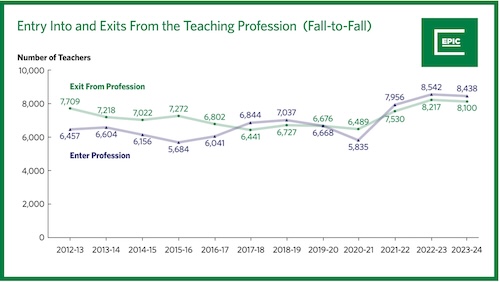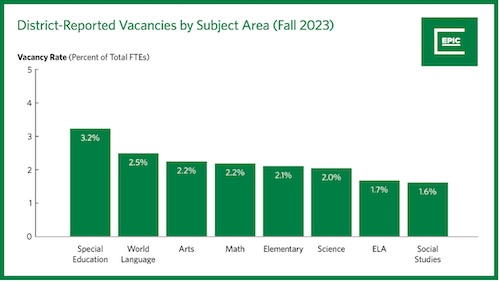A new report from Michigan State University’s Education Policy Innovation Collaborative, or EPIC, shows recent growth in the supply of Michigan teachers, but continued challenges with turnover and matching teachers’ credentials with schools’ needs.

The report finds that in each of the last three school years, teachers entered and exited the profession at elevated rates. Following two years of sharp increases, turnover rates started to stabilize in 2023-24 but remain higher than pre-pandemic levels. However, new teachers entering the workforce during this period outnumbered those who left. Together, these patterns indicate that the workforce is growing larger but is also less stable than before the COVID-19 pandemic.
These high rates of entry into the profession also mean that early-career teachers make up a larger share of the workforce than in the past. While most of these new teachers are recent graduates from traditional certification programs, many are interim-certified teachers enrolled in alternative-route programs and noncertified teachers working under temporary credentials like substitute permits. In 2023-24, teacher trainees with interim or temporary credentials held an all-time high of 8% of the state’s public school teaching assignments. The report cautions that while this trend could indicate that districts are successfully recruiting and training prospective teachers locally, it also means that many Michigan students are assigned to teachers who have not yet completed their training.
“For this recent growth to have a lasting impact, it will be critical that new teachers — especially those who are still trainees — receive the support they need to succeed and stay in the profession,” said Tara Kilbride, interim associate director of EPIC and lead author of the report.
Initial certification rates experienced a surge in 2023-24 after two years of slow growth. This recent increase was largely driven by teachers from alternative-route and out-of-state preparation programs. The number of newly certified teachers from these types of programs increased by 28% from 2022-23 to 2023-24, compared to a 5% increase in teachers from traditional in-state programs. Newly certified teachers are not only coming from different types of programs than in the past but are also more likely to teach in a Michigan public school after certification. Even though the total number of teachers earning their initial certification each year remains lower than it was a decade ago, the total number who work in a Michigan public school within a year of certification is higher.
The report shows that declines in initial certification persisted longer for special education than other teaching specializations. As a result, the number of incoming special education teachers has not been able to meet the demand. District-reported vacancy rates were higher for special education than any other type of teaching position, and many districts reported more than 10% of their special education positions vacant. High turnover rates among special education teachers further exacerbate these challenges.

The authors also noted that many districts in rural areas were susceptible to severe teacher shortages due to their smaller size and a limited supply of new teachers in their local area. These districts were more likely to experience high turnover and vacancy rates and often relied heavily on under-credentialed teachers.
The report finds that teachers from all types of locales tend to work in schools near or alike their own hometowns, and that this “draw of home” plays a particularly strong role in rural areas. Teachers from rural areas who switch districts within their first five years are about three times as likely to move closer to their hometowns than they are to move somewhere further from home. This pattern highlights the importance of recruiting prospective teachers from within the communities where they are needed most.
The authors note that many of the state’s current educator workforce initiatives align with the needs they identify in the report, but that these programs have not yet had enough time to achieve their intended impacts. For instance, the Section 27h Mentoring and Induction Grants aim to improve in-service training and guidance for early-career educators, while the Special Education Teacher Tuition Reimbursement Grant is designed to incentivize current teachers to earn special education credentials, and the MiCAREER Resource Hub targets teacher certification and staffing challenges in rural areas.
“While Michigan has earned national recognition for its success in addressing the teacher shortage, we need to do more,” said State Superintendent Michael Rice. “On the Michigan Department of Education’s recommendation, the legislature and governor have appropriated $1.1 billion the last three fiscal years for college scholarships and student teacher stipends for aspiring teachers, teacher student loan repayments, Grow Your Own programs for students and support staff to become teachers, mentoring and induction grants, and a rural credentialing hub. These investments are beginning to pay off and must continue. Additional funding for Grow Your Own programs for students and support staff to become teachers must be dedicated."